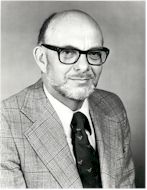David Slepian
- Birthdate
- 1923/06/30
- Birthplace
- Pittsburgh, PA, USA
- Death date
- 2007/11/29
- Associated organizations
- Bell Labs
- Fields of study
- Information theory
- Awards
- IEEE Information Theory Group’s Prize-Paper, IEEE Alexander Graham Bell Medal
Biography
David Slepian (IRE Associate 1952, Member 1957, Senior Member 1960, and Fellow 1962) was born in Pittsburgh, Pennsylvania on 30 June 1923. He attended the University of Michigan, Ann Arbor, from 1941 to 1943 at which time he entered the U.S. Army and served in the Signal Corps until 1946. From 1946 to 1949 he attended Harvard University, where he received the M.A. degree, in 1947, and the Ph.D. degree in physics, in 1949. He spent the academic year 1949-1950 at the University of Cambridge, England, and at the Sorbonne, Paris, as a Parker Fellow in physics from Harvard.
In 1950, Slepian joined the Mathematics Research Center at Bell Telephone Laboratories in Murray Hill, New Jersey, as a Research Mathematician and spent his career at Bell Labs. In his early years at Bell Labs, he worked on a wide variety of mathematical problems, making important fundamental contributions to the theory of switching and logic, and even designing a warhead for the NIKE missile. In the early 1950s, he turned his talents toward problems in communication or information theory, a discipline which was then in its early stages of development. It was here that he made his most remarkable contributions and established himself among the leading researchers in electrical engineering.
During the 1958-1959 academic year, Slepian was a Visiting McKay Professor of Electrical Engineering at the University of California at Berkeley. In the 1970s, Slepian shared his time between Bell Laboratories and the University of Hawaii, but returned to Bell Labs full time as head of an elite mathematical studies group in the 1980s.
Slepian's initial efforts in information theory were in the area of detection theory. While working in this area, he became aware of the information theoretic importance of prolate spheroidal wave functions. This led indirectly to his landmark collaboration with H.O. Pollak and H. J. Landau on the characterization of the bandwidth of electrical signals. His most important contribution to detection theory as such was his discovery of the possibility of singular detection. Over the years, he also published a number of important papers in the theory of stochastic processes, and was especially interested in zero-crossing problems for Gaussian noise.
Probably Slepian's most important work was done in the area of coding theory. Stimulated by Claude Shannon's early work, Slepian began his quest for good "error-correcting" codes in 1950. In his classic 1956 paper "A Class of Binary Signaling Alphabets," he introduced the now familiar notion of a binary group code. This paper was the first to formulate the coding problem in a modern algebraic setting and to exploit the algebraic properties of codes in a sophisticated way. As such, it was a landmark paper in the development of coding theory. And along with J. Wolf, Slepian made important contributions in the coding of multiple information sources.
Slepian received much recognition and many honors for his contributions, including selection by the IEEE Information Theory Group’s Prize-Paper award (along with J. Wolf) and was named as the group’s 1974 Shannon Lecturer (the group's highest honor). He was also elected as a Fellow of the IEEE and the Institute of Mathematical Statistics, as well as to the National Academy of Engineering and the National Academy of Sciences. He shared the latter with his late father, Joseph Slepian. David Slepian was also a member of AAAS, the American Mathematical Society, the Society for Industrial and Applied Mathematics, Commission VI of URSI, and Sigma Xi. In the IRE he served on the Administrative Committee of PGIT from 1958 to 1960 and in 1962 the Council on SIAM. In 1981, he received the IEEE Alexander Graham Bell Medal "For fundamental contributions to communication theory."
Further Research
David Slepian -- Family Memorial Page
